|
Beginning in the eleventh
century and continuing for several centuries wooden stave churches
were constructed in Norway. By the thirteenth century there were more
than a thousand stave churches. In the middle of the fourteenth
century the plague came to Norway and much of the country was left
unpopulated. The farm my family came from about 50 miles from
Trondheim was not resettled until the 1600's. Still the Grip
church was built as late as the 15th century, and the Hedared church
in Sweden dates as late as 1500. Today only around 30 remain. In 1992
the Fortun or Fantoft church near Bergen was the victim of arson.
Several of the churches have been moved, re-erected and
preserved at new locations. The Gol church was moved and reconstructed
at Bygdoy at the National Folk Museum. Parts of others are also stored
there. There is a stave church in Hedared, Sweden and one in
Greensted, Essex in England. The old Vang stave church from Valdres
Valley, Norway was sold to the King of Prussia, Fredrik Wilhelm IV,
who moved it to Karkonosze (Mountains) in Karpacz Górny (now Polish
territory) and rebuilt it there.
There are replicas of the Borgund church at Rapid City,
South Dakota and at seven-eights scale at Washington Island,
Wisconsin. The replicas at the Epcot Center, Disney World, Florida and
Hallingdal, Buskerud, Norway, are of the Gol church, and a copy of the
reconstruction has been built in Gol. There is a replica of the
Hopperstad church at Morehead, Minnesota. And a replica of the
Haltdalen church was built in 2001 on Heimwæy, one of the Vest-manna
Islands, on the site of Iceland's first church, built by Olav
Trygvasson.
The Haltdalen church was placed in the Sverresborg
Museum in Trondheim in 1882-1883. There are also plans to build a
replica of the stave church in Haltdalen.
The stave construction method uses vertical posts that
rest on a foundation as the main support structure, rather than a
horizontal planks or beams laid upon a foundation (as in a log cabin,
for example).
The site was usually a high, open area which was
conspicuous and prominent, places which bore "the special imprint of
God the creator." These locations were often on a peninsula,
overlooking a fjord, or at the bend in a river. The ground at the site
was leveled-out and the first wooden beams were laid out in a
rectangular pattern atop a stone foundation. Next, the staves (or
vertical posts) were erected. Cross-braces were then constructed
between the posts. Bent wooden arches were also added to most churches
between the staves for enhanced stability and decoration. Finally,
carvings, paintings, and other ornamentation were added to both the
interior and exterior of the churches.
Stave churches were made entirely of wood except for
ironwork detailing like door locks or hinges. The wood used was
specially cut and dried to prevent cracking. The only tools used in
the construction of the stave churches were axes, augers, primitive
planes, and various knives and chisels. The planks and pieces of wood
were dovetailed, pegged, and wedged so each joint could expand or
contract with the temperature and humidity, which varied greatly
from season to season in Norway.
Of the churches that remain, 3 churches, and carvings,
paintings, and tapestries from others have appeared on Norwegian
stamps.
Urness ~ ca. 1150
The
church in Urnes was built around 1050, and is generally agreed to be
the oldest stave church. The church was declared a "World Cultural
Heritage" in 1979 by the United Nations. According to the WCH, "The
church brings together traces of Celtic art, Viking traditions and
Romanesque spatial structures."

The
Urnes stave church in Sogn, built in the second half of the twelfth
century, contains a 100 year older church doorway. A four-legged
animal beset by dragons is the main motif on the jambs. On the curved
upper part dragons engage in battle. Serpents and dragons entwine in
writhing figures-of-eight, forming the basic element in the impressive
and delicately executed composition, with its roots in Viking art.

Borgund ~ ca 1150
The
Borgund stave church is the best preserved of the Norwegian stave
churches - it stands more or less as it was when built in 1150.

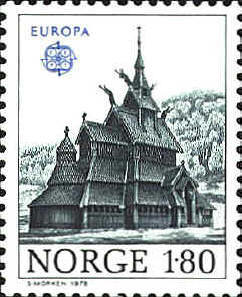
Heddal ~ ca. 1250
The oldest part of Heddal
stave church, the chancel, was probably built in 1147. This was quite
a small church, and only 95 years later the church was enlarged to the
present size. It is the largest stave church in existence.
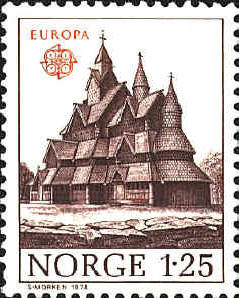
Ål Church ~ late 1200's
The Ål
church was pulled down in the 1880's, and a new church was built on
the site. The timber vaulting above the chancel, complete with painted
decorations dating from the later part of the 1200's, were acquired by
the University Museum of Antiquities in Oslo.
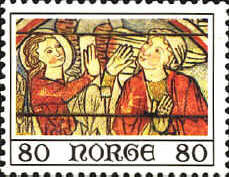 ; ;
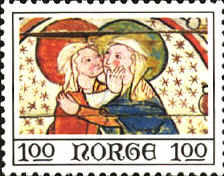
Annunciation
Visitation

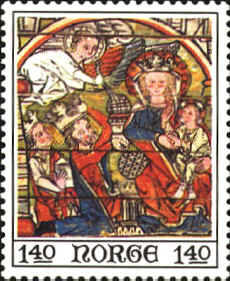
Nativity
Adoration
Baldishol Tapestry ~ 12th
Century
Two
months, April and May, of the Baldishol Tapestry, from the twelfth
century have been preserved, and are now in The Oslo Museum of Applied
Art. The section which has been preserved measures 118 by 203
centimeters. It is made out of wool from the Norwegian sheep,
spellsau. In some places flax has been used. The yarn, which was
dyed with vegetable dye, is red, yellow, green, or one of many shades
of blue. The fragment depicts an eleventh or twelfth century knight
similar to those of the Bayeux Tapestry. Although the tapestry was
discovered in an 18th century church, it is believed that it was
originally hung in a stave church.
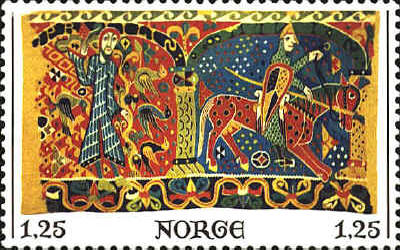
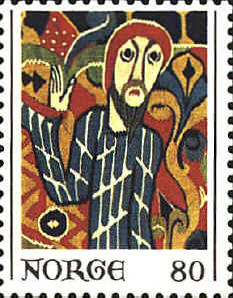

Skodvinar Church of Hemsedal ~
ca. 1207
The
Skodvinar church was built between 1207 and 1224. It was a triple-nave
church, with eight staves supporting the central nave. There were no
seats except for a bench on the outer walls. Everyone, except the old,
sick, or handicapped stood. Also, by law, everyone over the age of
twelve, except the sick, had to attend the services under penalty of
law.
When the church was torn down in 1882, the two portals
were preserved in the Museum of Antiquities in Oslo. The carving
on the stamp is from the west portal and represents one of the Three
Holy Kings who came to worship the Christ Child. The stamp was issued
in 1972 to mark the 1,100th anniversary of unification of Norway by
Harald Haarfager in 872. His descendents ruled Norway until the death
of Haakon V in 1319.
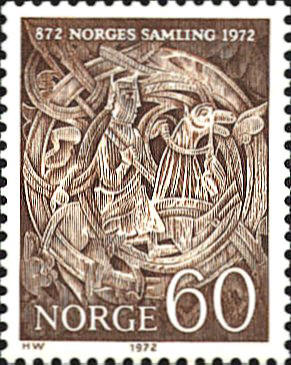
Hylestad Church of Setesdal ~
13th Century
The
Hylestad stave church was pulled down in the 19th century, and one of
its portals is now exhibited at the University Museum of Antiquities
in Oslo. The carving on the portal shows several scenes from the
legend of Sigurd Fåvnesbane.
Sigurd and Regin, a master swordsmith forged a sword
with which Sigurd killed the dragon, Fafnir. When Sigurd tasted the
broth from Fafnir's heart he was able to understand the language of
birds who reveled that Regin planned to betray Sigurd. Sigurd then
killed Regin and took Fafnir's treasure. The design on
the stamp shows Sigurd and Regin forging the sword.
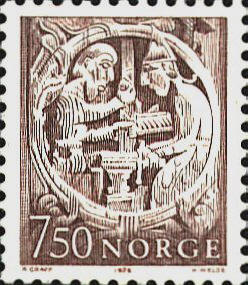
The second stamp (and its
background) shows the dragon Fafnir being killed by Sigurd
Fåvnesbane
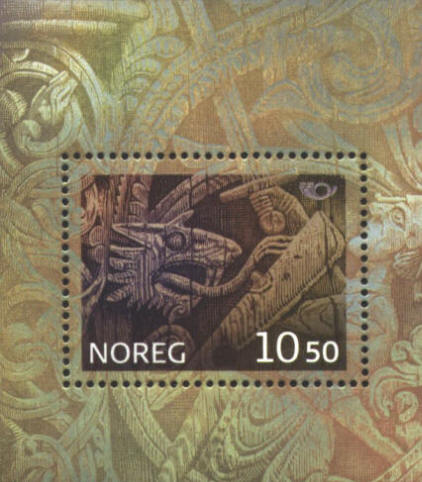
I would like to thank
David M. Walsten (rutoscdav@yahoo.com) for his help in preparing this
page. For further details I refer you to his 1994 book, Stave
Churches of the World, An Introduction.

|
